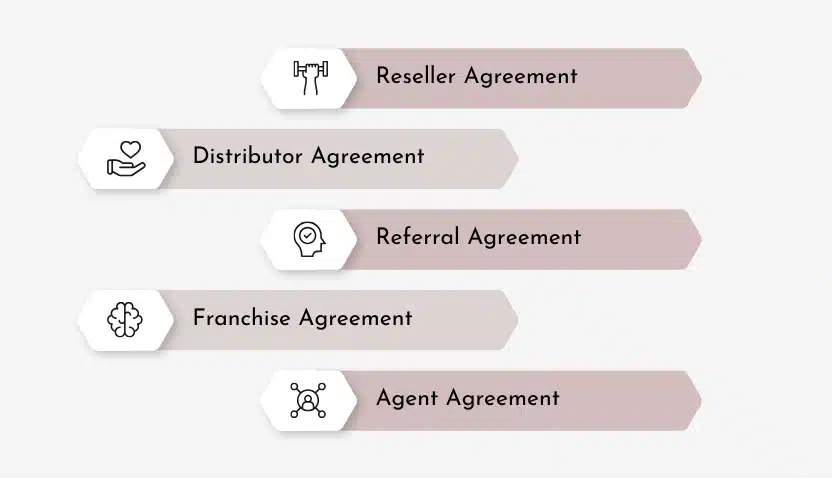Imagine two companies—one specializing in cutting-edge software, the other an expert in hardware distribution. Separately, they face hurdles in expanding their reach. But when they come together in a channel partnership, they unlock new markets, tap into each other’s strengths, and dramatically boost their revenue.
This is the power of a channel partnership. Through a clear partner agreement, businesses can align their goals, combine resources, and drive growth. It’s not just about increasing income; it’s about building a strong, strategic relationship that benefits both parties. By working together, companies can achieve far more than they would on their own.
What is a channel partner agreement?
A channel partner agreement clearly explains the terms and rules for working together between two businesses. These businesses are known as channel partners. This contract is legal and helps both sides understand how to work together in a good and helpful way.
This agreement is more than just a simple handshake. It goes into detail about the partnership. It clearly describes what each party is responsible for, including things like marketing, sales, and support. Also, it sets up rules for money transactions, rights to intellectual property, and sharing confidential information.
Key Components of a Channel Partner Agreement

- Scope of Partnership: This section defines the extent of the partner’s role, whether it’s reselling, distribution, or value-added services. It also identifies geographical regions or markets where the partner operates.
- Roles and Responsibilities: Clearly outlining each party’s responsibilities is crucial to avoid confusion. The agreement should include the partner’s duties in marketing, sales, support, and compliance with the vendor’s policies.
- Branding and Marketing Guidelines: This part outlines how the partner can use the vendor’s branding, trademarks, and promotional materials. Proper use of branding maintains consistency across markets and protects intellectual property.
- Training and Support: The vendor often provides training and support to ensure the partner can effectively market and sell the products. This section outlines the type and level of support the vendor will offer.
- Dispute Resolution: Given the global nature of many channel partner relationships, a well-drafted dispute resolution clause is vital. It specifies how conflicts will be resolved, including the jurisdiction and method of arbitration.
Types of a channel partner agreement
A Channel Partner Agreements can take various forms depending on the nature of the partnership, the products or services being sold, and the goals of the business relationship. Here are the most common types of Channel Partner Agreements:

1. Reseller Agreement
A Reseller Agreement allows the partner (reseller) to purchase products or services from the vendor and then sell them directly to customers. Resellers typically mark up the price to earn a profit.
- Key Features:
- The reseller acts as the primary seller to customers.
- The vendor may or may not have direct contact with the end customer.
- The reseller is responsible for marketing, selling, and supporting the product.
2. Distributor Agreement
A Distributor Agreement involves a partner who buys products from the vendor and distributes them to a network of resellers or retailers. The distributor acts as a middleman, often handling logistics, warehousing, and distribution.
- Key Features:
- Distributors manage inventory and ensure products reach retailers.
- They may have exclusive rights to distribute in a particular region.
- Vendors typically do not have direct relationships with the retailers in this model.
3. Referral Agreement
A Referral Agreement allows a partner to refer potential customers to the vendor. In exchange, the partner receives a commission or fee for successful sales or conversions.
- Key Features:
- The partner does not sell or distribute products but refers leads to the vendor.
- The vendor maintains control over the sales and customer relationship.
- Compensation is typically based on the number of successful referrals.
4. Franchise Agreement
A Franchise Agreement is similar to a channel partner agreement where a franchisee (partner) is allowed to use the vendor’s brand, products, and business model in exchange for fees or royalties.
- Key Features:
- The franchisee operates under the vendor’s brand and guidelines.
- They sell products or services in a specific territory.
- The vendor provides ongoing support, marketing, and training.
5. Agent Agreement
An Agent Agreement allows the partner (agent) to act on behalf of the vendor to sell products or services. The agent works under the vendor’s branding and guidelines, without taking ownership of the product.
- Key Features:
- Agents do not hold inventory but represent the vendor directly in negotiations and sales.
- The vendor typically handles fulfillment and customer support.
- Agents earn commissions based on the sales they generate.
You might want to read: What is a Franchise Agreement?
Structuring Your Channel Partner Agreement
A good channel partner agreement is important for handling the challenges of working together in business. It acts like a guide for both sides to create a strong and successful partnership.
You can think of it like building a house. You wouldn’t begin building without a clear plan. Each part of the agreement is like a building block. Together, they help make the partnership solid and strong.
Financial Terms and Compensation Models
Let’s be honest. A big part of any business partnership is about money. A good agreement must clearly say how the channel partner will get paid for their work. This means you need to say things like when payments happen, the ways to pay, and what happens if the payments are late.
The main focus here is to clearly say how the pay model works. Will you use a commission system? In this case, the partner gets a share of each sale they make. Or maybe you’ll choose a tiered pricing model? This means higher commission rates as sales increase.
Remember to think about things like currency changes, especially with partners from other countries. By making a fair and clear payment plan, you can create a strong and lasting business relationship. Covering these important details first helps to build trust and avoid problems later on due to money mix-ups.
Terms of Engagement and Duration
Every partnership needs a start date and maybe an end date. This part of the agreement shows when the partnership begins (effective date) and how long it will last. Will it be a one-year contract with a chance to renew? Or will it be a plan that continues until one side decides to stop it?
It is important to think about your business and what you want from the partnership when choosing how long it should last. For example, if you are launching a new product, a shorter time frame that can be extended later may work better. This way, you can see how well the partnership is doing before making a long-term commitment.
Also, explain how renewal will work. Will it happen automatically, or will both parties need to review it formally? By making these points clear, both sides will know how long the partnership will be, which helps in making smart business choices. This removes any confusion and helps both sides transition easily, whether the partnership is extended or ends naturally.
Termination Clauses and Exit Strategies
While it’s optimistic to focus on a successful partnership, real-world business requires planning for contingencies. This is where termination clauses come in. This section outlines the circumstances under which the agreement can be terminated, providing both parties with exit strategies if the partnership doesn’t work out as planned.
Clearly state the grounds for termination, which could include breach of contract, failure to meet performance targets, insolvency, or a material change in control of either party. Specify the notice period required for termination and outline the process for winding down the partnership.
|
Grounds for Termination |
Notice Period |
|
Breach of Contract |
30 days |
|
Failure to Meet Performance Targets |
60 days |
|
Insolvency |
Immediate |
|
Material Change in Control |
90 days |
By including termination clauses, you’re not being pessimistic; you’re being pragmatic. This section provides a safety net, ensuring a clear and legally sound pathway for dissolving the partnership if circumstances require it, minimizing potential conflicts and ensuring a smooth transition.
You might want to read: What is a Termination Clause in Contracts?
Common Pitfalls to Avoid in Channel Partner Agreements
Navigating the process of creating a partner agreement for your channel takes careful attention. Small mistakes can lead to big problems later.
This section points out common issues that businesses face when drafting and gives useful tips to help you avoid these troubles.
Vague Terms and Unclear Expectations
One common mistake in channel partner agreements is using unclear language. What does “best efforts” mean in marketing? What is a “reasonable” time to deliver goods? When expectations are not clear, it can cause misunderstandings and disagreements.
For example, if your agreement says the channel partner will promote your products, it does not say how, how often, or what methods to use. This lack of clarity could lead the partner to do less work, leaving you unhappy. To prevent this, use specific words in your agreement.
Instead of unclear terms, set clear expectations. State target numbers, timelines, and the methods or channels to use. By being clear and straightforward in your language, you will help both parties understand each other. This will lower the chance of misunderstandings and disputes.
Lack of Flexibility in the Agreement
The business world is always changing. Market trends, customer habits, and your own business plans can shift at any time. If your channel partner agreement isn’t flexible, it might become old quickly. This can hurt your partnership’s growth and cause disagreements.
For instance, think about having a set commission rate for your channel partner. If suddenly your product sales soar, your partner could benefit greatly while you feel left out. To prevent this, make sure your agreement allows for changes.
You could add items that allow regular check-ins. This way, you can update the terms based on what is happening. Whether it is changing the commission, looking at how well the partnership is doing, or adding new products or services, being flexible is very important.
Ignoring Market Changes and Dynamics
The business world is always changing. New competitors come up, technologies improve, and customer tastes change. If you do not consider these changes when making your channel partner agreement, you might face serious problems.
For example, what if your agreement is only about selling products through traditional stores? If e-commerce suddenly becomes very popular in your industry, your agreement might not fit this new situation. This could make your partnership fall behind and even cause frustration between both sides.
To avoid these problems, include some flexibility for market changes in your agreement. Think about adding clauses that let you review the sales strategy, introduce new products, or switch to different sales channels based on trends. By accepting that change is normal and building ways to adjust into your agreement, you can keep your partnership strong and competitive even when the market shifts.
Best Practices for Negotiating Channel Partner Agreements
Negotiating a channel partner agreement is all about finding a balance. You need to support your business’s needs while also building a good relationship with your potential partner. It is not just about trying to win everything; instead, focus on common goals that help both sides over time.
This part shares the best tips to succeed in these talks. You can secure good terms and create a strong partnership that benefits everyone.
Preparing and Doing Your Homework
Entering a negotiation without preparing is like going to battle without any weapons. Before you sit down, do some research on your potential partner. This work is crucial. It helps you understand how they run their business, their place in the market, and any strengths or weaknesses they might have.
Look into their past partnerships if you can. Have they been involved in any legal issues? What is their reputation in the industry? Also, think about what your business needs are. Make a list of things you cannot change and areas where you can be flexible.
By taking time to prepare, you will gather useful information. This can help you gain an advantage in the negotiation. Also, knowing your partner’s viewpoint will lead to better conversations. It creates a respectful atmosphere and helps both sides reach a deal that benefits everyone.
Focusing on Mutual Benefits
A successful channel partnership needs to be a win-win for both sides. It can be tempting to only think about getting the best deal for your business. However, it’s important to think about how both parties can benefit.
Ask yourself, “How can this partnership help us both?” You might give your partner access to your wide distribution network for a better commission rate. Or, you could use their established customer base to launch a new product together. This way, you can share the marketing costs and enjoy the benefits together.
By finding common ground and working towards shared goals, you chances of reaching an agreement that works for both parties improve. This builds a sense of partnership instead of just a business deal. In the end, this leads to a better and more successful partnership.
Building Long-Term Relationships
In a negotiation, your main goal is to reach a good agreement. However, it’s also important to think about creating a strong, long-term relationship. A channel partnership built on trust, respect, and open communication can last even as markets change.
When you negotiate, work together and try to connect with your potential partner. Show that you care about the partnership by being clear about what you want. Listen to their concerns and find solutions that work for both sides.
By creating a friendly atmosphere from the start, you lay the groundwork for a strong partnership. Remember, a good agreement is only the beginning. A successful channel partnership needs constant work, clear communication, and a shared goal of helping each other succeed.
You might want to read: What Is Contract Negotiation?
Advantages of channel partner agreements?
- Increased Market Reach: Partners help expand business into new regions or markets, accessing untapped customer bases.
- Cost Efficiency: Reduces the need for large sales and marketing teams as partners handle these efforts.
- Leverage Partner Expertise: Partners often have specialized knowledge of the local market or industry.
- Shared Risk: Partners share the burden of risks like market changes, reducing the overall risk for both parties.
Disadvantages of channel partner agreements?
- Loss of Control: Partners act independently, which can lead to inconsistent branding or customer experiences.
- Revenue Sharing: Profit margins may decrease as revenues are split with partners.
- Dependency Risks: Over-reliance on a partner can be risky if their business fails or priorities change.
- Complex Coordination: Managing and aligning goals between different partners may increase operational complexity.
Conclusion
Channel Partner Agreements are essential for building strong business relationships. They define the payment terms, conditions of this agreement, and the confidentiality obligations of each party. Clear terms of this agreement outline responsibilities, helping businesses manage potential challenges with their channel partners, whether they are wholesalers, retail companies, or referral partners as part of a channel partner program.
Carefully drafted agreements should include all critical details such as ownership rights, license fees, and necessary measures for compliance. Businesses must ensure that key provisions like termination of the agreement, warranties, and indemnification are addressed to avoid disputes. The termination section should specify how and when the term of this agreement can end, with flexibility in the business practices to adapt to different types of resellers.
Negotiations should be approached in good faith, focusing on mutual benefits and long-term success. Businesses should avoid vague language, ensuring specifications, use of service marks, and personal data protections are well defined. Provisions against attempts to reverse engineer proprietary materials, misuse of the company’s trade name, logo, and trade secrets should also be included to protect ownership rights.
Regularly reviewing and adjusting agreements based on the type of partner, from wholesalers to referral program members, ensures alignment and reduces risks. Using a flexible template while considering warranties, precedence, and the specific module or subject matter of the agreement helps maintain clarity and trust across all channels.
FAQs
What are the first steps in setting up a channel partner agreement?
The first steps in making a channel partner agreement are to define what the partnership will cover. You need to set clear goals and outline duties. It is important to have a written agreement that makes everything clear and shows transparency.
How can you measure the success of a channel partner agreement?
Success can be measured by clear KPIs. These focus on sales growth, market reach, customer happiness, and finding new leads. Also, regular reviews help us check how well partnerships are doing.
How often should channel partner agreements be reviewed?
It’s a good idea to check your channel partner agreements at least once a year. In fast-changing markets, it’s smart to do this more often. You should make updates to match new conditions or to improve continuously.
Can channel partner agreements be customized for different types of partners?
Customization is very important. Channel partner agreements need to be designed to fit the unique needs and business styles of each type of partner. This makes sure they are useful and work well.






